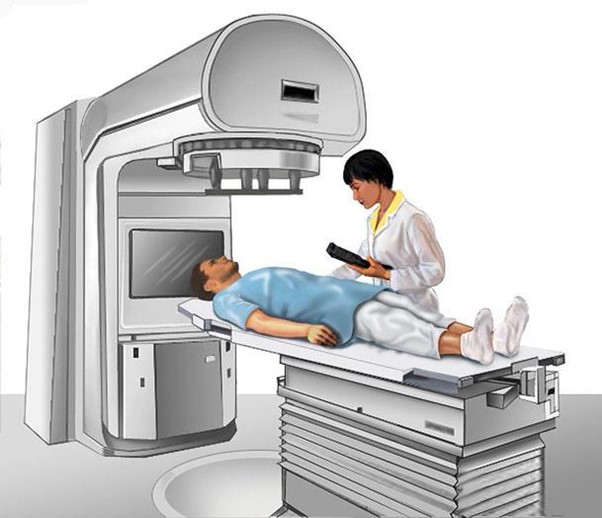A nurse is providing teaching to a client who is to begin external radiation therapy for cancer. Which of the following information should the nurse include?
"You might experience altered taste sensations."
"Use rubbing alcohol to remove the ink markings."
"Wear a binder over the radiation site."
"Wash your skin thoroughly with a washcloth after each treatment."
The Correct Answer is A
Choice A reason:
"You might experience altered taste sensations" is the correct statement. When providing teaching to a client about to undergo external radiation therapy for cancer, the nurse should include information about potential side effects and what to expect during the treatment. One common side effect of radiation therapy, especially when the treatment is focused on or near the head and neck region, is altered taste sensations. Radiation can affect the taste buds and lead to changes in how foods taste.
Choice B reason:
"Use rubbing alcohol to remove the ink markings. “The statement is incorrect. The ink markings made on the client's skin are used as reference points for the radiation therapy treatment. It is essential not to remove these markings, as they are crucial for accurate positioning during each treatment session. The nurse should instruct the client not to tamper with the markings, and the radiation therapy team will remove them when they are no longer needed.
Choice C reason:
"Wear a binder over the radiation site." The statement is incorrect. Wearing a binder over the radiation site is not a standard practice during external radiation therapy. The client should be instructed to follow the specific guidelines provided by the radiation therapy team regarding clothing and positioning during treatments. The use of binders or other tight clothing over the treatment area may not be recommended, as it can cause discomfort or interfere with the delivery of radiation.
Choice D reason
"Wash your skin thoroughly with a washcloth after each treatment." Is incorrect statement. During radiation therapy, the skin in the treatment area can become sensitive. It is essential for the client to follow the specific instructions provided by the radiation therapy team regarding skin care. Generally, the client should avoid using harsh soaps or scrubbing the skin vigorously. Instead, they should gently cleanse the area with a mild soap or as directed by their healthcare providers.

Nursing Test Bank
Naxlex Comprehensive Predictor Exams
Related Questions
Correct Answer is ["B","C"]
Explanation
The correct answers are B and C.
Choice A Reason: Transferring a client who is receiving radiation therapy involves understanding the precautions and care associated with radiation, which may be beyond the training of assistive personnel (AP). Radiation therapy clients may have specific safety and transport protocols that require the expertise of licensed nursing staff.
Choice B Reason: Measuring vital signs for a client who requires contact precautions is a task that can be delegated to AP. Assistive personnel can be trained in infection control procedures and the use of personal protective equipment (PPE), making them capable of measuring vital signs while adhering to contact precautions.
Choice C Reason: Recording urine output for a client who has a suprapubic catheter can be delegated to AP. This task involves measuring and documenting a quantifiable data point, which does not require the clinical judgment of a nurse. AP can be trained to accurately measure and record urine output.
Choice D Reason: Planning care for a client who has dysphagia is a complex task that involves assessment and clinical judgment, which are responsibilities of the licensed nurse. Dysphagia can have serious complications, and care plans must be tailored to each client’s needs, requiring the expertise of a nurse.
Correct Answer is B
Explanation
Choice A reason:
Completing an incident report is not the correct action. An incident report should be completed as part of the hospital's protocol to document the medication error and ensure appropriate follow-up and investigation.
Choice B reason:
Checking the client for indications of bleeding is the correct action to be taken. In this situation, the nurse's first priority should be to assess the client for indications of bleeding, as the client received a significantly higher dose of IV heparin than prescribed. Heparin is an anticoagulant medication used to prevent blood clots, and an overdose can increase the risk of bleeding.
After administering the wrong dose of medication, the nurse's immediate concern is the client's safety and well-being. Checking for signs of bleeding, such as petechiae, ecchymosis, hematomas, bleeding gums, melena (black, tarry stools), haematuria (blood in urine), or any other unusual bleeding, is crucial.
Choice C reason:
Monitor the client's aPTT levels: This is not the correct action to be taken. Monitoring the client's activated partial thromboplastin time (aPTT) levels is essential to assess the client's coagulation status and determine if the overdose of heparin has affected their clotting ability. The healthcare provider may adjust the heparin dosage based on the aPTT levels.
Choice D reason:
Notify the risk manager: This is not the correct action to be taken. The risk manager or appropriate supervisor should be informed about the medication error as soon as possible to initiate a thorough review of the incident and take necessary steps to prevent similar errors in the future.
Whether you are a student looking to ace your exams or a practicing nurse seeking to enhance your expertise , our nursing education contents will empower you with the confidence and competence to make a difference in the lives of patients and become a respected leader in the healthcare field.
Visit Naxlex, invest in your future and unlock endless possibilities with our unparalleled nursing education contents today
Report Wrong Answer on the Current Question
Do you disagree with the answer? If yes, what is your expected answer? Explain.
Kindly be descriptive with the issue you are facing.
